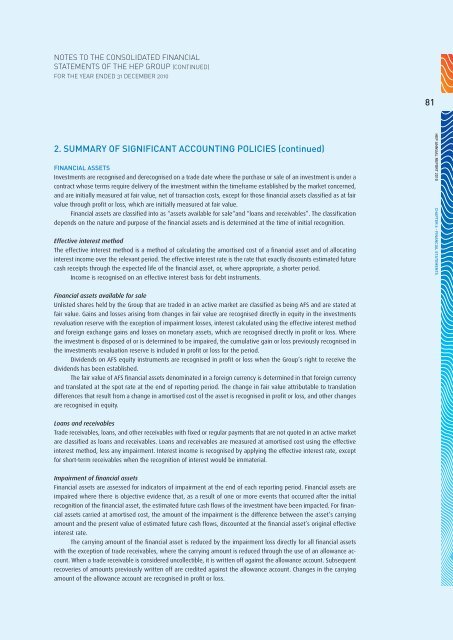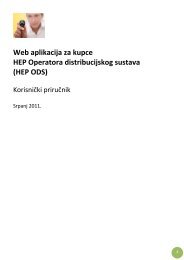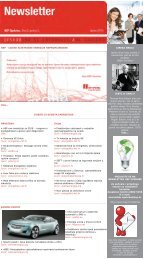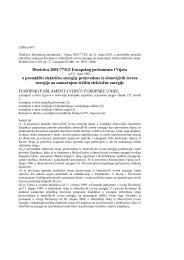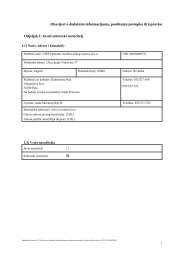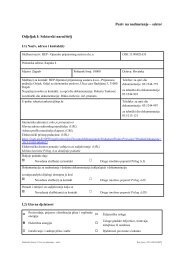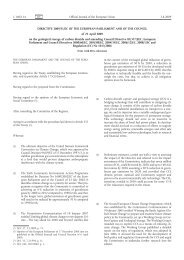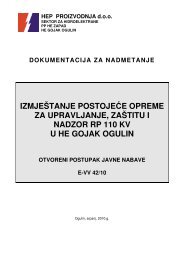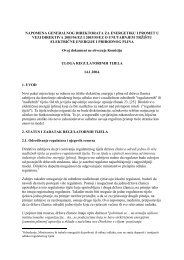DRAVA, KUPA, RJE»INA, LOKVARKA, LI»ANKA LIKA, DOBRA ...
DRAVA, KUPA, RJE»INA, LOKVARKA, LI»ANKA LIKA, DOBRA ...
DRAVA, KUPA, RJE»INA, LOKVARKA, LI»ANKA LIKA, DOBRA ...
You also want an ePaper? Increase the reach of your titles
YUMPU automatically turns print PDFs into web optimized ePapers that Google loves.
NOTES TO THE CONSOLIDATED FINANCIAL<br />
STATEMENTS OF THE HEP GROUP (CONTINUED)<br />
FOR THE YEAR ENDED 31 DECEMBER 2010<br />
2. SUMMARY OF SIGNIFICANT ACCOUNTING POLICIES (continued)<br />
FINANCIAL ASSETS<br />
Investments are recognised and derecognised on a trade date where the purchase or sale of an investment is under a<br />
contract whose terms require delivery of the investment within the timeframe established by the market concerned,<br />
and are initially measured at fair value, net of transaction costs, except for those financial assets classified as at fair<br />
value through profit or loss, which are initially measured at fair value.<br />
Financial assets are classified into as “assets available for sale“and “loans and receivables”. The classification<br />
depends on the nature and purpose of the financial assets and is determined at the time of initial recognition.<br />
Effective interest method<br />
The effective interest method is a method of calculating the amortised cost of a financial asset and of allocating<br />
interest income over the relevant period. The effective interest rate is the rate that exactly discounts estimated future<br />
cash receipts through the expected life of the financial asset, or, where appropriate, a shorter period.<br />
Income is recognised on an effective interest basis for debt instruments.<br />
Financial assets available for sale<br />
Unlisted shares held by the Group that are traded in an active market are classified as being AFS and are stated at<br />
fair value. Gains and losses arising from changes in fair value are recognised directly in equity in the investments<br />
revaluation reserve with the exception of impairment losses, interest calculated using the effective interest method<br />
and foreign exchange gains and losses on monetary assets, which are recognised directly in profit or loss. Where<br />
the investment is disposed of or is determined to be impaired, the cumulative gain or loss previously recognised in<br />
the investments revaluation reserve is included in profit or loss for the period.<br />
Dividends on AFS equity instruments are recognised in profit or loss when the Group’s right to receive the<br />
dividends has been established.<br />
The fair value of AFS financial assets denominated in a foreign currency is determined in that foreign currency<br />
and translated at the spot rate at the end of reporting period. The change in fair value attributable to translation<br />
differences that result from a change in amortised cost of the asset is recognised in profit or loss, and other changes<br />
are recognised in equity.<br />
Loans and receivables<br />
Trade receivables, loans, and other receivables with fixed or regular payments that are not quoted in an active market<br />
are classified as loans and receivables. Loans and receivables are measured at amortised cost using the effective<br />
interest method, less any impairment. Interest income is recognised by applying the effective interest rate, except<br />
for short-term receivables when the recognition of interest would be immaterial.<br />
Impairment of financial assets<br />
Financial assets are assessed for indicators of impairment at the end of each reporting period. Financial assets are<br />
impaired where there is objective evidence that, as a result of one or more events that occurred after the initial<br />
recognition of the financial asset, the estimated future cash flows of the investment have been impacted. For financial<br />
assets carried at amortised cost, the amount of the impairment is the difference between the asset’s carrying<br />
amount and the present value of estimated future cash flows, discounted at the financial asset’s original effective<br />
interest rate.<br />
The carrying amount of the financial asset is reduced by the impairment loss directly for all financial assets<br />
with the exception of trade receivables, where the carrying amount is reduced through the use of an allowance account.<br />
When a trade receivable is considered uncollectible, it is written off against the allowance account. Subsequent<br />
recoveries of amounts previously written off are credited against the allowance account. Changes in the carrying<br />
amount of the allowance account are recognised in profit or loss.<br />
81<br />
HEP ANNUAL REPORT 2010<br />
CHAPTER 6 - FINANCIAL STATEMENTS


